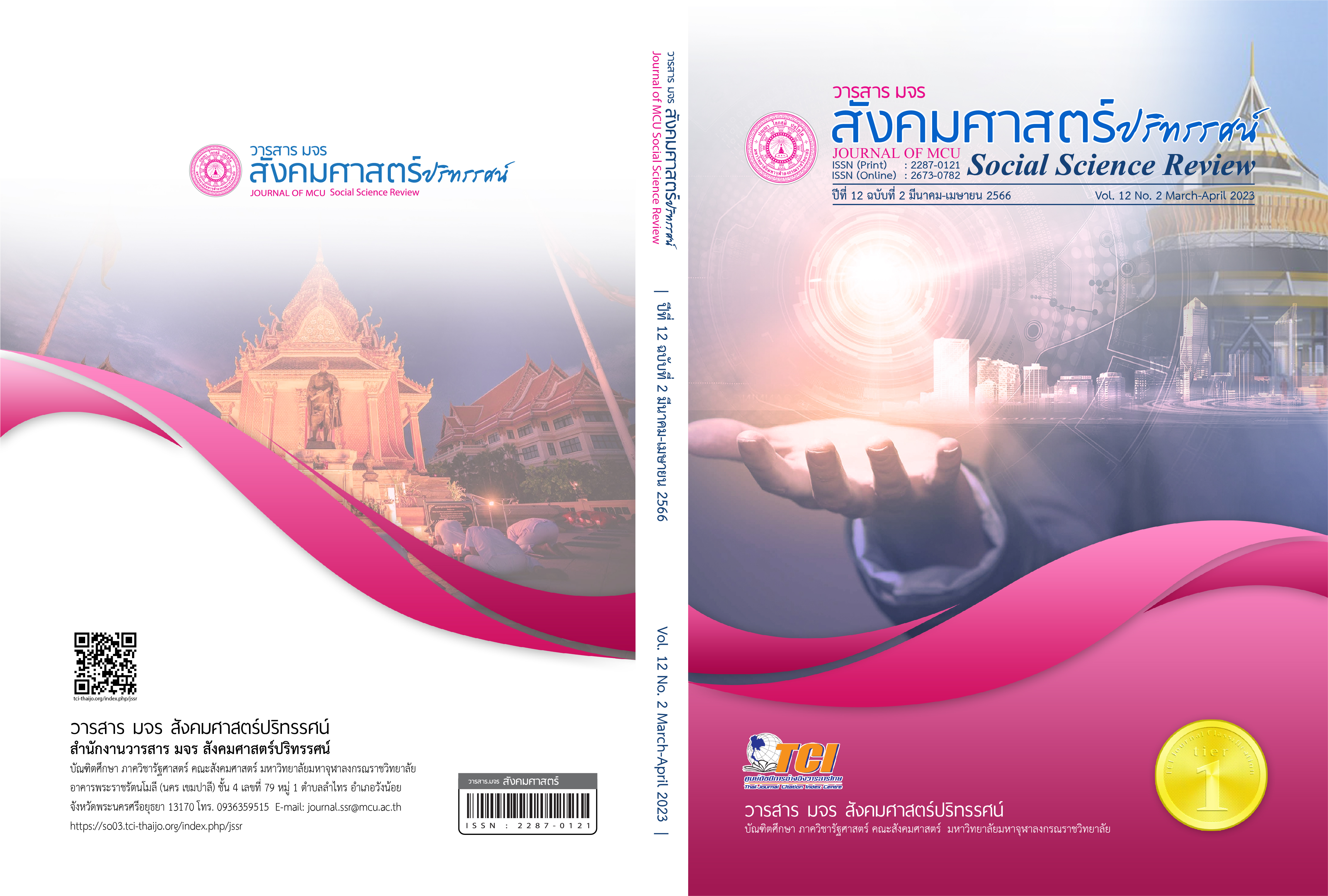องค์ประกอบภาวะผู้ตามที่มีประสิทธิผลของครูในโรงเรียนมัธยมศึกษาสังกัดสำนักงานคณะกรรมการการศึกษาขั้นพื้นฐานในภาคตะวันออกเฉียงเหนือ
คำสำคัญ:
องค์ประกอบ, ภาวะผู้ตามที่มีประสิทธิผล, ครูมัธยมศึกษาบทคัดย่อ
บทความนี้มีวัตถุประสงค์เพื่อศึกษาองค์ประกอบภาวะผู้ตามที่มีประสิทธิผลของครูในโรงเรียนมัธยมศึกษา สังกัดสำนักงานคณะกรรมการการศึกษาขั้นพื้นฐาน ในภาคตะวันออกเฉียงเหนือ เป็นการวิจัยเชิงบรรยาย กลุ่มเป้าหมาย คือ การสัมภาษณ์ผู้ทรงคุณวุฒิ จำนวน 11 คน และการศึกษาพหุกรณี จำนวน 2 โรงเรียน ด้วยวิธีการเลือกแบบเจาะจง เครื่องมือที่ใช้ในการสัมภาษณ์เป็นแบบกึ่งโครงสร้าง สถิติที่ใช้ ความถี่ ร้อยละ
ผลการวิจัยพบว่า องค์ประกอบภาวะผู้ตามที่มีประสิทธิผลของครูในโรงเรียนมัธยมศึกษา สังกัดสำนักงานคณะกรรมการการศึกษาขั้นพื้นฐาน ในภาคตะวันออกเฉียงเหนือ ประกอบด้วย 6 องค์ประกอบหลัก และ 25 องค์ประกอบย่อย ได้แก่ 1) ความรับผิดชอบ ประกอบด้วย 5 องค์ประกอบย่อย คือ ความเพียรพยายาม ความเอาใจใส่ในการทำงาน การยอมรับการกระทำของตน ความละเอียดรอบคอบ และการปรับปรุงงานให้ดียิ่งขึ้น 2) การพัฒนาตนเอง ประกอบด้วย 3 องค์ประกอบย่อย คือ การวิเคราะห์ตนเอง การจัดการตนเอง และการแสวงหาความรู้ในการพัฒนา 3) การคิดอย่างมีวิจารณญาณ ประกอบด้วย 4 องค์ประกอบย่อย คือ การพิจารณาอย่างมีเหตุผล ความกระตือรือร้น ความคิดสร้างสรรค์ และการเปิดใจกว้าง 4) มนุษยสัมพันธ์ ประกอบด้วย 4 องค์ประกอบย่อย คือ แรงจูงใจ การยอมรับตนเอง การจัดการความขัดแย้ง และการปรึกษาหารือ 5) การทำงานเป็นทีม ประกอบด้วย 4 องค์ประกอบย่อย คือ การติดต่อสื่อสาร การมีเป้าหมายเดียวกัน การมีปฏิสัมพันธ์ และการมีส่วนร่วม และ 6) ความกล้า ประกอบด้วย 5 องค์ประกอบย่อย คือ ความกล้าที่จะรับผิดชอบในการกระทำของตน ความกล้าที่จะมีส่วนร่วมในการเปลี่ยนแปลง ความกล้าที่จะยืนหยัดในศีลธรรม ความกล้าที่จะอาสาช่วยทำงาน และความกล้าที่จะท้าทาย
เอกสารอ้างอิง
กิตติทัช เขียวฉะอ้อน. (2560). การทำงานเป็นทีมสู่การเพิ่มประสิทธิผลในการทำงาน. วารสารวิทยาลัยดุสิตธานี,11(1), 355-370.
จุรีรัตน์ นันทัยทวีกุล. (2558). การวิเคราะห์องค์ประกอบคุณลักษณะและความรับผิดชอบ ของนักเรียน ชั้นมัธยมศึกษาปีที่ 1 ในกรุงเทพมหานคร (ปริญญานิพนธ์ กศ.ม.). กรุงเทพฯ: มหาวิทยาลัยศรีนครินทรวิโรฒ.
ณภูผา โพธิมา. (2561). โมเดลความสัมพันธ์เชิงโครงสร้างตัวบ่งชี้ภาวะผู้ตามที่มีประสิทธิผลสำหรับครู สังกัดองค์กรปกครองส่วนท้องถิ่น (ดุษฎีนิพนธ์ปริญญาศึกษาศาสตร์ดุษฎีบัณฑิต สาขาวิชาการบริหารการศึกษา). ขอนแก่น: มหาวิทยาลัยมหามกุฎราชวิทยาลัย วิทยาเขตอีสาน.
ทรงกลด เจริญศรี. (2550). ความสัมพันธ์ระหว่างสติปัญญาทางอารมณ์ กับภาวะผู้นำและผู้ตามของพยาบาลวิชาชีพโรงพยาบาลทั่วไป เขต 11 ภาคตะวันออกเฉียงเหนือ กระทรวงสาธารณสุข.(วิทยานิพนธ์ พย.ม.). ขอนแก่น: มหาวิทยาลัยขอนแก่น.
บุญใจ ศรีสถิตนรากูร. (2551). ภาวะผู้นำและกลยุทธ์การจัดการองค์การพยาบาลในศตวรรษที่ 21.(พิมพ์ครั้งที่ 2). กรุงเทพฯ: โรงพิมพ์แห่งจุฬาลงกรณ์มหาวิทยาลัย.
มณฑป ไชยชิต. (2551). การพัฒนาตนเองของครูสู่ความเป็นเลิศ. สืบค้น 18 พฤษภาคม 2564, จาก http://krukob.com/web/v21-5/.
วรางคณา กาญจนพาที. (2556). ภาวะผู้นำและภาวะผู้ตามที่มีอิทธิพลต่อประสิทธิผลองค์กร: กรณีศึกษา ธนาคารเพื่อการส่งออกและนำเข้าแห่งประเทศไทย. ปทุมธานี: มหาวิทยาลัยเทคโนโลยีราชมงคลธัญบุรี.
สามารถ อัยกร, ประภัสสร ดาวะเศรษฐ์, สายป่าน จักษุจินดา และชาญชัย ศุภวิจิตรพันธุ์. (2560). บทบาทของผู้ตามในคุณลักษณะภาวะผู้ตามแบบมีประสิทธิผล. วารสารวิขาการมหาวิทยาลัยปทุมธานี, 9(1), 195-203.
สุเทพ พงศ์ศรีวัฒน์. (2560). ภาวะผู้นำ. สืบค้น 23 ธันวาคม 2563, จาก http//pongsriwat@thaimail.com.htm.
สุรีย์รัตน์ พัฒนเธียร และพร้อมพิไล บัวสุวรรณ. (2552). ตัวแบบความสามารถทางภาวะผู้นำครูในสถานศึกษาขั้นพื้นฐาน. วารสารเกษตรศาสตร์ (สังคม), 30(2), 130-142.
สำนักงานคณะกรรมการการศึกษาแห่งชาติ. (2553). พระราชบัญญัติการศึกษาแห่งชาติ พ.ศ.2542 และที่แก้ไขเพิ่มเติม (ฉบับที่3) พ.ศ.2553. กรุงเทพฯ: สำนักนายกรัฐมนตรี.
ศรีวรรณ แก้วทองดี. (2562). แนวทางการพัฒนาตนเองของครูในสถานศึกษา สหวิทยาเขตบึงสามพันสังกัดสำนักงานเขตพื้นที่การศึกษามัธยมศึกษา เขต 40 (วิทยานิพนธ์ครุศาสตรมหาบัณฑิต สาขาวิชาการบริหารการศึกษา). นครสวรรค์: มหาวิทยาลัยราชภัฏนครสวรรค์.
อุดม ทุมโฆษิต. (2553). สถิติสำหรับการวิเคราะห์เชิงปริมาณเพื่อการวิจัยทางรัฐประศาสนศาสตร์. กรุงเทพฯ: สถาบันบัณฑิตพัฒนาบริหารศาสตร์.
อนุพงศ์ อวิรุทธา. (2555). ใครคือผู้ตามที่ดีในองค์กร. สืบค้น 26 กรกฎาคม 2564, จาก https://www. siamturakij.com.
Barrette, E. (2010). Followership: An important partner of leadership. business and management horizons, Retrieved January 14, 2021, from https://bit.ly/2tyKvnB
Blackshear, G. (2003). The Managerial Grid III. Houston: Gulf Publishing.
Chaleff, I. (2009) The Courageous follower: Standing up to and for our leaders. SanFrancisci: Berrett-Koehler.
Kelly, R. E. (2008). The Power of Followership: Howto create leaders people want to follow and followerswho lead themselves. New York: Doubleday.
Keshavarzi, A., Hoveida, R. & Siadat, S. A. (2015). The Degree of the Components of Human Relation Management Application by the Principals of First Course of High Schools in Isfahan from Teachers Standpoint. Journal of Applied Environmental and Biological Sciences, 5(2), 314-319
Lateur, S. M. & Rast, V. J. (2004). Dynamic followership the prerequisite for effective leadership. Retrieved. January 22, 2021, from https://bit.ly/2dYY1vz.
Lussier, R. N. & Achua, C. F. (2001). Effective Leadership. 3rd ed. Ohio: South-Western.
Martin, R. (2008). Followership: An important partner of leadership. business and management horizons. Retrieved January 14, 2021, from https://bit.ly/2tyKvnB
Mccallum, J .S. (2013). Followership: the other side of leadership. Retrieved January 11, 2016, from https://bit.ly/1KKEyr5.
Miller, C. A. (2007). Out in the World: Gay and Lesbian Life from Buenos Aires to Bangkok. London: Penguin Books.
Sillivan, P & Decker, J. (2009). Communication Skills for the Health Care Professional: Concepts and Techniques. Maryland: Aspen.
Tappen Weiss & Whitehead. (2004). Action Research Principles and Practice. Mackays of Chamtham PLC, Chatham, Kent.
Thach et al. (2006). Action Research (2nded.). California: Sage.
Thompson, G. & Morrisl, L. (2006). Blended learning: how to integrate online and traditional learning. London: Kogan Page.
Villiers, R. D. (2014). Followership: how to act the other 98% of the time, when we aren’t leading. Retrieved January 14, 2021, from https://bit.ly/2yCprSX.
Weiss, J. B. (2001). The Provision of Social Relationship. Englewood Cliff, N. J: Prentice-Hall.
Ye, Y. (2020). Factors Relating to Teachers’ followership in international universities in Thailand. Retrieved December 11, 2020, from http://www.assumptionjournal.au.edu/index.php/Scholar/article/view/856/765.
ดาวน์โหลด
เผยแพร่แล้ว
รูปแบบการอ้างอิง
ฉบับ
ประเภทบทความ
สัญญาอนุญาต
ลิขสิทธิ์ (c) 2023 วารสาร มจร สังคมศาสตร์ปริทรรศน์

อนุญาตภายใต้เงื่อนไข Creative Commons Attribution-NonCommercial-NoDerivatives 4.0 International License.
เพื่อให้เป็นไปตามกฎหมายลิขสิทธิ์ ผู้นิพนธ์ทุกท่านต้องลงลายมือชื่อในแบบฟอร์มใบมอบลิขสิทธิ์บทความให้แก่วารสารฯ พร้อมกับบทความต้นฉบับที่ได้แก้ไขครั้งสุดท้าย นอกจากนี้ ผู้นิพนธ์ทุกท่านต้องยืนยันว่าบทความต้นฉบับที่ส่งมาตีพิมพ์นั้น ได้ส่งมาตีพิมพ์เฉพาะในวารสาร มจร สังคมศาสตร์ปริทรรศน์ เพียงแห่งเดียวเท่านั้น หากมีการใช้ภาพหรือตารางหรือเนื้อหาอื่นๆ ของผู้นิพนธ์อื่นที่ปรากฏในสิ่งตีพิมพ์อื่นมาแล้ว ผู้นิพนธ์ต้องขออนุญาตเจ้าของลิขสิทธิ์ก่อน พร้อมทั้งแสดงหนังสือที่ได้รับการยินยอมต่อบรรณาธิการ ก่อนที่บทความจะได้รับการตีพิมพ์ หากไม่เป็นไปตามข้อกำหนดเบื้องต้น ทางวารสารจะถอดบทความของท่านออกโดยไม่มีข้อยกเว้นใดๆ ทั้งสิ้น





